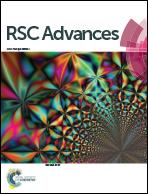Step economical synthesis of o-aryl benzamides via C–H activation relayed by the in situ installation of directing group: a multicomponent method†
Abstract
Multicomponent reactions have been successfully applied as a platform for designing the step economical C–H activation-based organic synthesis wherein the in situ installation of directing group (DG) and the subsequent C–H activation-based amide arylation have been achieved in one-step. This multicomponent strategy allows the efficient synthesis of 2,6-biarylated or 6-arylated benzamides with significantly improved sustainability and discloses the potential of designing “ideal” synthesis by combining the concepts of C–H activation and multicomponent reaction.


 Please wait while we load your content...
Please wait while we load your content...